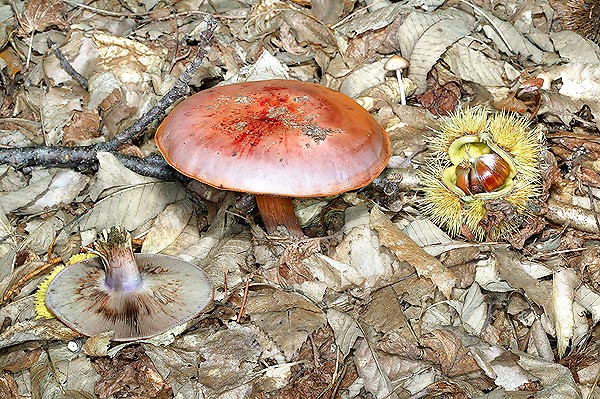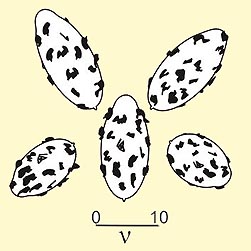Text © Bruno Gasparini

English translation by Mario Beltramini

Red, vinous cap, unpleasant smell, bitterish taste © Giuseppe Mazza
Family: Cortinariaceae.
Genus: Cortinarius.
Subgenus: Calochroi.
Section: Fulvi.
Cortinarius rufoolivaceus (Persoon) Fries 1838.
Immediately recognised on the field by the winy-red colour of the cap and olivaceous of the gills, which cannot escape the attention of any collector.
Cap: 5-10 (12) cm, convex, then planar, occasionally also depressed.
Cuticle very viscous-glutinous, smooth with membranous debris of a winy-coloured veil, carmine pink or wine red, paler toward the margin, sometimes greenish particularly in the variety pallidus.
Gills: dense, fragile, slightly serrate, annexed-seceding, pale olive.
Stalk: sometimes hefty, sometimes slimmer, up to 12 cm in length, 15 mm wide, cylindrical, pale greenish-reddish, bulbous, bulb onion-shaped, emarginated by a wine-red veil.

The spores © Bruno Gasparini
Contest: firm, pale in the sap, greenish in the stalk, reddish-lilac in the bulb.Odour rather unpleasant. Taste bitterish.
Habitat: under broadleaf particularly in warm climate (Oaks, olm-oaks, horn-beam).
Chemical reactions: on the cap KOH (or NaOH) immediately green, then slowly red.
Spore: lemonshaped, grossly verrucose 10-13 x 6-7,5.
Notes. This attractive Phlegmacium in section Fulvi .M.M. Moser 1975 possesses a neutral monoanthraquinone (phiscion), some dimeric anthraquinones, naphthoquinones of heptaketidic origin, plus phlegmacins and rufoolivacine of octaketidic origin. Anthraquinones are potentially toxic or carcinogenic Taxonomically speaking, Fulvi are affine to Calochroi, which tests made with suggest to be a self-standing subgenus of Cortinarius. It is a group of vivaciously coloured Cortinarius, yellow red, blue, green, vinaceous, etc.
Synonyms: Cortinarius decoratus Bataille; Cortinarius orichalceus var. russus Quél. p.p.; Hydrophorus rufolividus Battara; Agaricus Cortinaria rufoolivaceus Alb. & Schwein; Cortinarius rufoolivaceus var. decoratus Bataille; Cortinarius russus ss. Quélet, sec. Konrad & Maublanc; Cortinarius testaceus Cooke 1883; Cortinarius vinosus Cooke 1883.
→ For general notions about Fungi please click here.
→ To appreciate the biodiversity of MUSHROOMS please click here.
